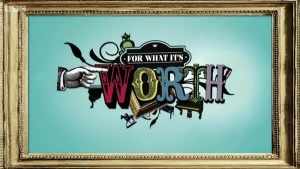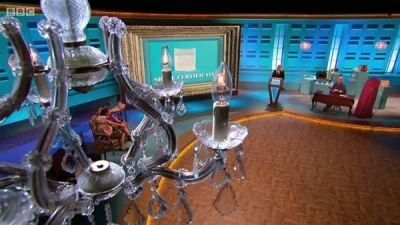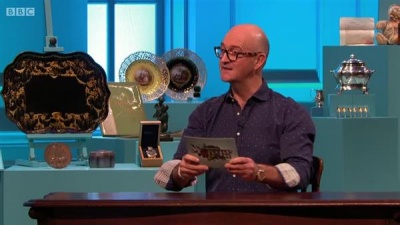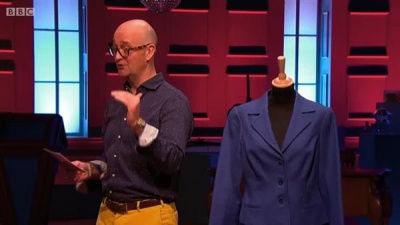For What It's Worth
(→Web links) |
|||
| Line 1: | Line 1: | ||
| - | [[File:For what its worth title.jpg|300px]] | + | <div class="image">[[File:For what its worth title.jpg|300px]]</div> |
<div class="box"> | <div class="box"> | ||
| Line 13: | Line 13: | ||
== Broadcast == | == Broadcast == | ||
| - | Tuesday's Child for BBC One, 4 January 2016 | + | Tuesday's Child for BBC One, 4 January to 26 June 2016 (48 episodes in 2 series) |
</div> | </div> | ||
| Line 25: | Line 25: | ||
For the opening round, the quizzer tries to buzz in before the other two quizzers. A right answer allows the picker the choice of items from the 16 on the board. Once someone's picked an antique, it joins the others in their collection and cannot be chosen by another team. An incorrect answer means the quizzer cannot answer the next question; their error is not passed to the other sides. | For the opening round, the quizzer tries to buzz in before the other two quizzers. A right answer allows the picker the choice of items from the 16 on the board. Once someone's picked an antique, it joins the others in their collection and cannot be chosen by another team. An incorrect answer means the quizzer cannot answer the next question; their error is not passed to the other sides. | ||
| - | <div class=image> | + | <div class=image>[[File:For what its worth studio chandelier.jpg|400px]]''The set is elegant, vast — and empty.''</div> |
| - | [[File:For what its worth studio chandelier.jpg|400px]] | + | |
| - | ''The set is elegant, vast — and empty.'' | + | |
| - | </div> | + | |
After the opening round, each team asks the day's antiques expert about one of the 16 items in the day's game. The experts are familiar from [[Bargain Hunt]] and other BBC daytime shows. | After the opening round, each team asks the day's antiques expert about one of the 16 items in the day's game. The experts are familiar from [[Bargain Hunt]] and other BBC daytime shows. | ||
| Line 38: | Line 35: | ||
After all of this, the team whose collection has the lowest value is eliminated. The expert discusses and values all of their items, and anything left on the main board. These items are out of the game. The teams can then ask about another antique left in the game. | After all of this, the team whose collection has the lowest value is eliminated. The expert discusses and values all of their items, and anything left on the main board. These items are out of the game. The teams can then ask about another antique left in the game. | ||
| - | <div class=image> | + | <div class=image>[[File:For what its worth antiques expert.jpg|400px]]''This antiques expert knows the provenance and price of everything.''</div> |
| - | [[File:For what its worth antiques expert.jpg|400px]] | + | |
| - | ''This antiques expert knows the provenance and price of everything.'' | + | |
| - | </div> | + | |
Round three is a bit like a [[Who Dares Wins]] tiebreak. Quizzers alternate answers that fall into a category. Whoever goes wrong / repeats / hesitates first has lost, and the other team will bring something into their collection. Three lists ends the round. | Round three is a bit like a [[Who Dares Wins]] tiebreak. Quizzers alternate answers that fall into a category. Whoever goes wrong / repeats / hesitates first has lost, and the other team will bring something into their collection. Three lists ends the round. | ||
| Line 47: | Line 41: | ||
Again, the team with the less valuable collection is out of the game. The winners then pick one item from their collection, the one they hope is the "top lot" or worth plenty. | Again, the team with the less valuable collection is out of the game. The winners then pick one item from their collection, the one they hope is the "top lot" or worth plenty. | ||
| - | <div class=image> | + | <div class=image>[[File:For what its worth mystery jacket.jpg|400px]]''Do you want to gamble your watch against this mystery jacket?''</div> |
| - | [[File:For what its worth mystery jacket.jpg|400px]] | + | |
| - | ''Do you want to gamble your watch against this mystery jacket?'' | + | |
| - | </div> | + | |
But the game isn't over: the winners are then offered a swap with a mystery object. They don't know the value of their own item, they've had no time to think about the mystery object. Swap, or not? | But the game isn't over: the winners are then offered a swap with a mystery object. They don't know the value of their own item, they've had no time to think about the mystery object. Swap, or not? | ||
| Line 87: | Line 78: | ||
[[Category:Antiques]] | [[Category:Antiques]] | ||
| - | |||
Revision as of 16:14, 6 May 2017
Contents |
Host
Co-hosts
Kate Bliss, Charles Hanson, David Harper, Natasha Raskin, Charlie Ross
Broadcast
Tuesday's Child for BBC One, 4 January to 26 June 2016 (48 episodes in 2 series)
Synopsis
Pairs of players answer general knowledge questions to select an antique. The winning pair will win the cash value of their selected item.
Before the game, the three pairs - a "quizzer" and a "picker" have been given some time with the 16 antiques on today's show. We see some highlights of the pairs poking at bottles, lifting the lid on teapots, and staring deep into inkwells. Amongst the antiques is a "top lot", worth a few thousand; and a "bottom lot", something so damaged that it could not be sold at auction.
For the opening round, the quizzer tries to buzz in before the other two quizzers. A right answer allows the picker the choice of items from the 16 on the board. Once someone's picked an antique, it joins the others in their collection and cannot be chosen by another team. An incorrect answer means the quizzer cannot answer the next question; their error is not passed to the other sides.
After the opening round, each team asks the day's antiques expert about one of the 16 items in the day's game. The experts are familiar from Bargain Hunt and other BBC daytime shows.
Categories join the antiques for round two, one for each row and another one for each column. In turn, the picker chooses an antique; their quizzer chooses the category from the row and column. Again, a right answer allows the piece to join that team's collection.
Round two continues for a second pass. The picker can choose something from the board, or something from another team's collection that they think will be valuable. Trying to pilfer something from my collection? I'll defend the item and choose the category you'll answer on, from all eight on the board.
After all of this, the team whose collection has the lowest value is eliminated. The expert discusses and values all of their items, and anything left on the main board. These items are out of the game. The teams can then ask about another antique left in the game.
Round three is a bit like a Who Dares Wins tiebreak. Quizzers alternate answers that fall into a category. Whoever goes wrong / repeats / hesitates first has lost, and the other team will bring something into their collection. Three lists ends the round.
Again, the team with the less valuable collection is out of the game. The winners then pick one item from their collection, the one they hope is the "top lot" or worth plenty.
But the game isn't over: the winners are then offered a swap with a mystery object. They don't know the value of their own item, they've had no time to think about the mystery object. Swap, or not?
The team wins the value of the item they keep - the mystery object, or the one they brought from the main game.
For What It's Worth has some jeopardy (though it's very difficult for winning teams to leave with nothing), and enough of a plot to sustain the programme. We're not convinced that there's quite enough to fill 45 minutes, in particular the discussions about the antiques' origin and price do drag on.
Inventor
A Tuesday's Child format, developed by Gail Harman and Phil Tredinnick
Theme music
Dobs Vye, credited for "Music"
Trivia
According to the original publicity, each antiques expert was going to be on screen for a week, like Countdown's Dictionary Corner. This was changed late on so that each expert took one day each week.
Values on the show are estimated "hammer prices" at an auction, excluding any fees for the sale.
Not to be confused with 4 What It's Worth, a 1980s consumer affairs programme hosted by Penny Junor.





